Safari Field Guides
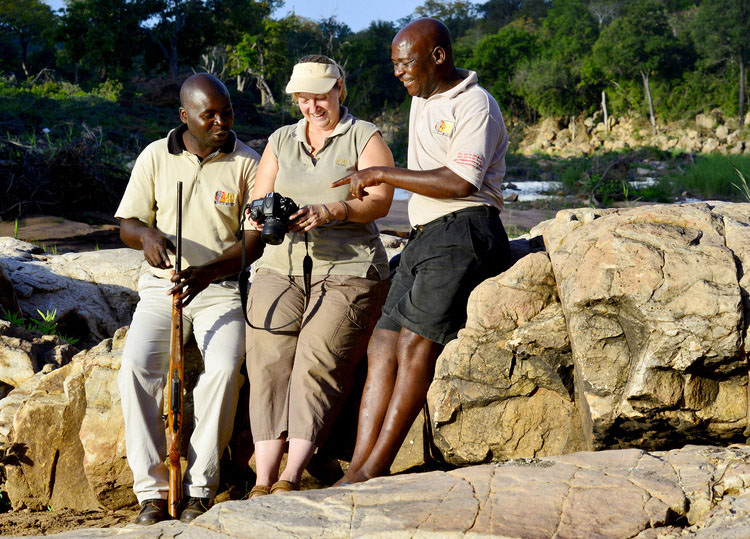
Safari Field Guides are the people who are the critical link between the guest and the game experience, as they can either make or break your African photo safari.
As a visitor to the national parks you want an overall good experience and this includes the food, service, accommodation, and game drives. As a wildlife photographer all these things are important but the most important are the game drives because the safari field guide can make all the difference in you coming home with winning images or not.
What’s the point of eating good food, receiving great service, having restful sleeps but not getting the images you most wanted!?
Safari Field Guides vs Game Rangers
Before we go any further let’s just define the difference between safari field guides and game rangers as some people do get them confused.
Game Rangers usually work for the park and are responsible for the resource management of game reserves/national parks. They work with ecologists to manage the animal populations of reserves. They are also responsible for maintaining the roads, fencing, water resources, erosion control, alien plant control, burning programmes, population control and bush clearing and sometimes the field guide will be asked to help the game rangers with these tasks.
Safari field guides, or nature guide as they are also known, usually work at a lodge and have the task of interacting with guests by taking them out, either on foot, in vehicles, or on canoes/boats, into wilderness areas and enhancing their wilderness experience by educating them on all aspects of nature, including mammals, birds, reptiles, insects, plants, grasses, soils, trees, weather and astronomy but most of all, field guiding is about meeting their guests’ expectations and fulfilling their dreams by showing them what they have come to see.
Here is a quote from the Field Guides Association of Southern Africa (FGASA) Training Manual that sums up the field guide role:
“The key to being a good nature guide is the ability to create a unique guided nature experience and promote conservation. It is about combining one’s individual talents, abilities and personality with educating and entertaining guests and instilling in them an interest in all aspects of nature and ensuring that they have a richly rewarding experience. People who do well as nature guides are generally passionate about nature, enthusiastic, good communicators and get on well with people.”
Jenny and I have been on well over 150 guided game drives in various parks such as Etosha, Lake Manyara, Ngorongoro Crater, Kgalagadi, Pilanesberg, Madikwe and the Kruger Park so we have experienced a wide variety of safari field guides, from the good to the bad and the ugly!
The point of this page is not to criticize the
guides but to warn you, the guest, what to expect and how to try and not get
teamed up with the bad or ugly guide. We also want to educate the safari field guides
who want to learn to provide their guests with an enhanced wildlife
experience.
Safari Field Guides – three Types:
From what we have experienced we can break guides down into three categories:
Those that love nature - They love being outdoors, can be really quiet and you may have to push them for info, but when they give you the info they are very knowledgeable.
Those that love people - These guides love interacting with people and you can end up spending more time talking about other things than about animals and the bush.
Those that love themselves - These guides tend to be in it primarily for the money and could not be bothered about nature or the people. You can often hear them bragging about things that most probably never happened as their primary goal is to impress their guests in order to get a bigger tip.
The ideal safari field guide tends to be a combination of the first two – a guide who loves nature but can also communicate well with guests. A bonus is if the guide is a photographer as s/he should then also understand what your photography needs are and hopefully make creative suggestions at each sighting.
Armand Grobler of Rhulani Safaris is one such guide - humble, knowledgeable and he's a good photographer. He offers Big Cat Photo Safaris in the greater Kruger Park, to places like the Sabi Sand, Manyeleti and Timbavati Game Reserves.
Manyeleti Big Cat Photographic Safaris!
We used to think that the most important criteria for a guide was that they should be a photographer but one photographer-guide who we were paired with would make sure that he was in the best position so that he could get the shot while we were positioned with twigs or bushes in front of us!
We now realise the most important trait for a safari field guide is ‘humility’. If the guide is humble s/he will tend to listen to the guest’s requests and not be stubborn and do the exact opposite.
They will realise that they don’t know everything and that they should be willing to learn new things and most importantly – the stubborn, know-it-all guide will get NO TIP from us! Some guests feel obligated to give tips yet the tip is for service 'above and beyond'.
Safari Field Guides – what they are taught:
(All quotes are from what other guests have written on TripAdvisor so that you can see it's not just us who feel this way)
The most frustrating part of many of our safaris has been the field guides so we decided to examine the 60-day FGASA Course: Nature Guiding FGASA Level 1 that all of them should have attended and passed. Here are some of the course topics that relate to wildlife photography:
Safari Field Guides - Approach of game:
Many of our guides race up to the subjects and chase them away or get so close we are photographing the tops of their heads!
We suggest they stop at least 50 meters away from the
subject to let the guests with long lenses get a few shots, then drive closer
so the medium length lenses get some shots and then last get even closer so
that the iPads and smart phones can get some shots but it seems they are
programmed for just one tactic - get as close as possible as soon as possible
as they are chasing tips and think close
= bigger tip.
We were on a night drive in Madikwe and we spotted an African Wild Cat that had just caught a mouse. It was walking through the grass on our left and was heading to cross the road diagonally in front of us. The guide then sped up to cut the cat off and the more we shouted at him to ‘STOP!’ the faster he drove! This was the shot we got:
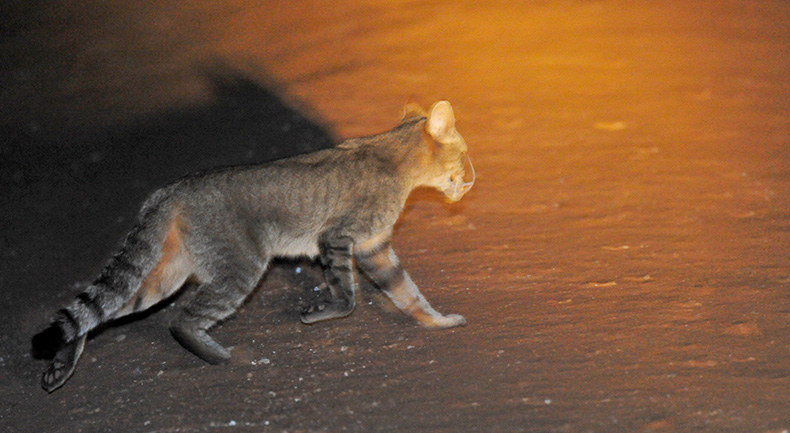 Horrible blurred image - but it could have been a wow image...
Horrible blurred image - but it could have been a wow image...The African Wild Cat is a rare sighting - this was the only one we had seen in Madikwe. If we were on a once-in-a-lifetime safari that would have been our one and only opportunity wasted because of a stubborn safari field guide!
Fortunately we are going back to Madikwe and we are hoping for better field guides who will listen to client requests! This particular field guide was subsequently fired for endangering client's lives by speeding in the park. If the 'small' deviant behaviors are ignored they soon grow to serious deviant behaviors.
Safari Field Guides - How to shine spotlights:
Most guides and trackers shine all over the place - we are just getting the subject in focus and they move the beam, then we focus on the second subject and the beam moves back to the first!
Edward Peach, our Photographer’s Guide to the Pilanesberg National Park eBook co-author is a very good field guide and photographer and that’s why we teamed up with him on the book.
When he trained he sat on the tracker seat and learnt how to use the spotlight while moving, but when stationary it was sighting dependent and he was trained to always bounce the light off something for nocturnal animals, and never shine on diurnal animals.
What Edward found worked the best for photos at night was to ask the guests if they want photos of the subject and then tell them to get ready as he shone the light next to the subject so they could get focus. Then he would open the beam and then with the dispersed beam shine on the animal for the guests to get their shots and then move the light off, thus limiting direct light on the animal.
Also using a wide beam allowed for more balanced lighting and was not as sharp on the subject’s eyes. If you shine a bright spotlight into an animal’s eyes they will most probably move away.
We experienced this first-hand – we came across a leopard about 30 meters in front of us, sitting in a clearing and looking at us. I asked the tracker to please NOT shine onto the subject but to shine next to the leopard so that I could focus – what does he do – he shines directly into the leopard’s eyes and the leopard closes his eyes, gets up and disappears into the night...!
We spend hours looking for the leopard and when we find one the tracker chases him away!!
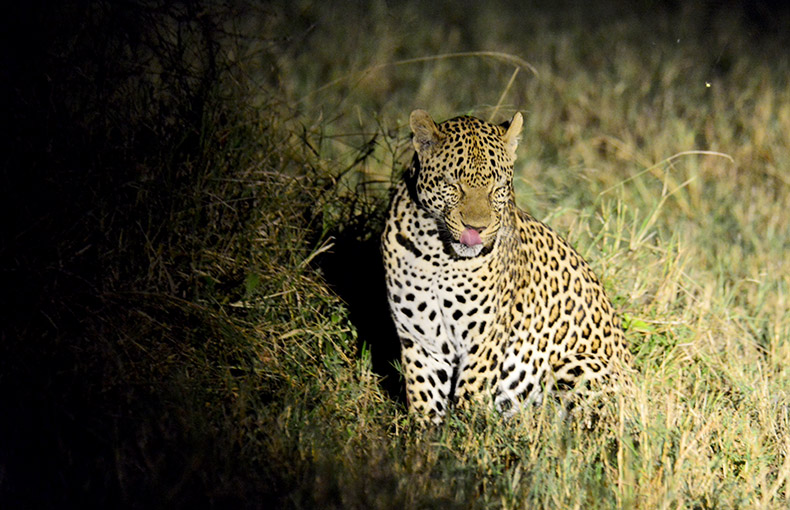
Not all guides are stubborn - while at Cheetah Plains in the Sabi Sand Reserve we came across a pride of lions at night. We wanted a back-lit image of the male, which we got..
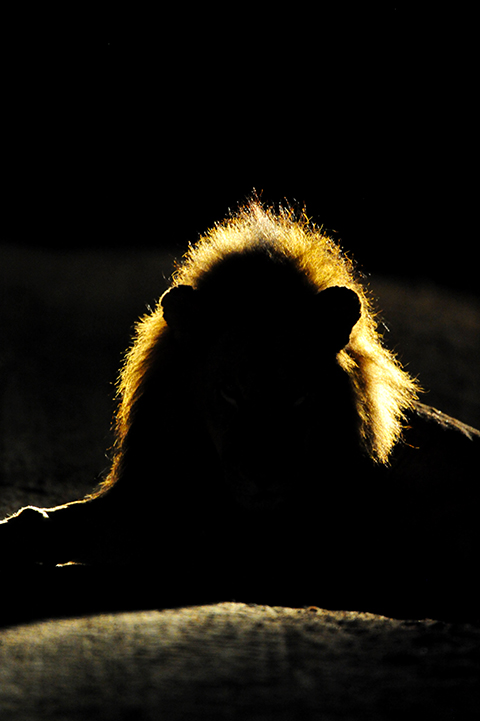
We obviously needed a second vehicle to help with the spotlight so our guide (Justin Glanvill) called the other Cheetah Plains vehicle to the sighting and asked that field guide to shine behind on the ground behind the lion (not ON the lion!), which he did. Now that's good teamwork!
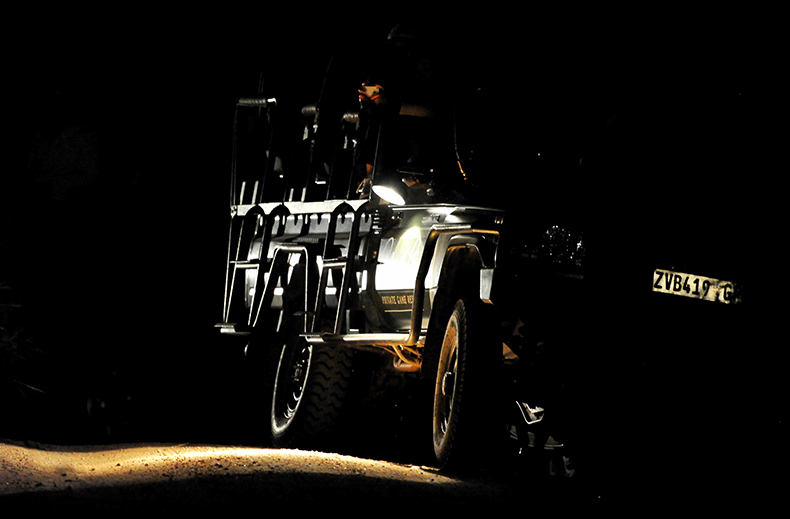
Safari Field Guides & Wildlife photography:
According to Edward, there wasn't much focus on photography during his training as the other topics tended to take priority. There was mention of basic photography techniques to keep in mind such as vehicle position, direction of sun, staying still on the vehicle, etc., but the main focus was more on the average guest and not the wildlife photographer.
“The only minor negative I would say was that, as photographers, we found that the ranger didn't always turn off the engine when we stopped and, when he did, he didn't always tell us when he was about to start off again!”
Our one guide kept talking
and gesticulating with his hands so we often got hand or head blurs in our photos.
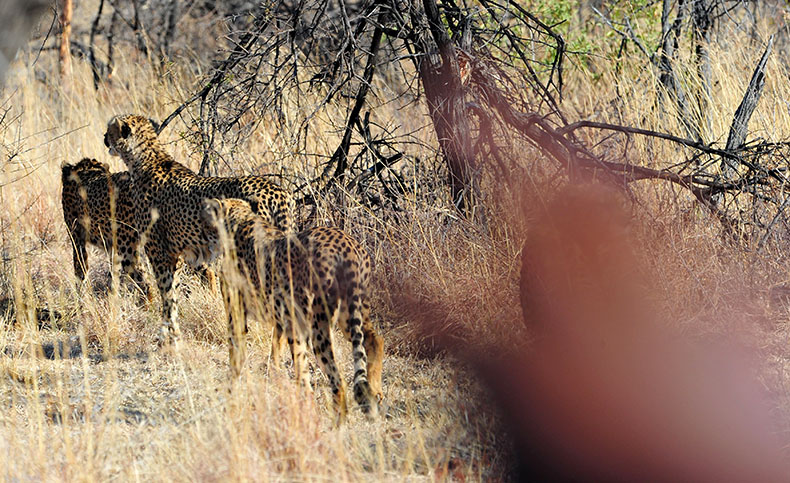
He didn't keep the sun behind us, he would spend no more than 10 minutes at each sighting and then just start the vehicle and drive off even though we were the only vehicle there and he also kept moving and rocking the vehicle – I think guides don’t realise the amount of play the suspension has so they do not think their ‘slight movements’ will affect the photos.
Every day we had to ask him to bend his aerial down and hook it under the side mirror so that we wouldn't get it in our images.
This particular guide stopped for us to watch the four cheetah brothers stalking zebras but instead of him concentrating on the subjects he proceeds to turn around so that his back is towards the subjects and we get the standard cheetah lecture while the cheetahs are hunting their prey. Other vehicles are driving past us in order to keep up with the cheetahs while our guide is giving us a biology lesson!
For those safari field guides who want to add value to their wildlife photography guest's game drives, please don't tell us about the gestation period of an elephant, or about a zebra's stripes - rather help your guests anticipate the subject's behavior before it happens, which will allow us to capture great photographs of it!! This applies to both the wildlife photographer and the average guest.
Most guests are too nice to say anything but we speak among ourselves and we have all heard the biology stories - rather help us to capture better photographs as these are the mementos that we take home with us after our safari.
These are the reminders or keepsakes that we will show our friends and family members that will hopefully encourage them to also come and spend their money at your lodges - the gestation period of an elephant will not!!
“The guide we went with was very good at spotting game and he even found us a caracal. The only problem seemed to be that the guide didn't have much knowledge about photography, light or angles, which meant from a photography point of view this trip was a write off for me. Also, the guide was very keen to move on to the next animal rather than spend time with what was in front of us at the time and manoeuvre the car into a better position.”
Another annoying habit of many guides is that they will drive behind the subjects walking in the roads for mile after mile. Who wants photos of animals backsides?! Just let the guide know that you want to photograph the subject's face and ask him to drive around the animals when he has a chance.
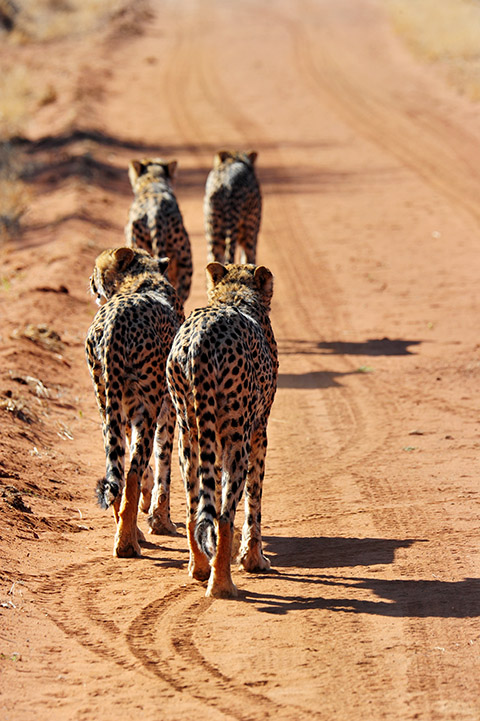 |
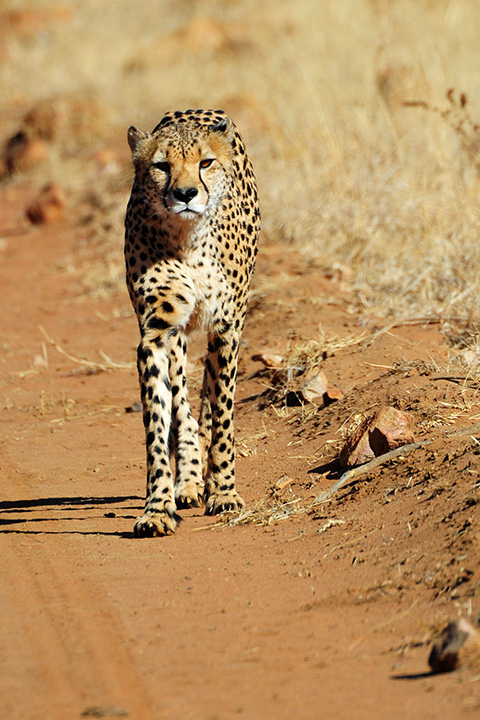 |
Safari Field Guides - How to do a game drive:
Here seems to be a common belief amongst guides that they need to race everywhere to see as much as possible in order to get a bigger tip.
We found that safari field guides can be split into two categories when it comes to finding subjects – the finders and the followers.
The finders go out and find animals while the followers
simply chase sightings that are called in on the radios. Both have their place
but we tend to prefer the finders.
“We have experienced many game drives in Madikwe and what stood out clearly for us were Franco's respect, love and knowledge of nature. Instead of responding to the calls going over the radio we travelled the bush in search of sightings and were privileged enough to see the big five and more. Seeing Franco enjoy the sightings and not telling us all the tourist stories was a welcome change.”
Edward was a finder and would mostly go where ever no one else was going so he could stay away from the traffic and chaos and this often led him to some awesome sightings that made the other guides jealous but the others still chose the easier route – follow the radio calls and then queue.
On a safari in Madikwe we were looking for an old leadwood tree to photograph as the lodge we were staying at was named after the tree (Motswiri). While looking for a suitable tree we found two black rhinos - a rare sighting in the park!
On another safari we asked to see some springbok on the plains in Madikwe, and on the way to the plains we spot a leopard on a rock! Chasing after animals is not fun and we tend to find much more when relaxed and looking for unexciting subjects.
At a lodge in Madikwe one of the guests on our vehicle made the comment, "it seems like he wants to show us every part of the reserve instead of just staying close to the lodge - we are tired of just driving for miles".
I understand that many guests want to see the big-5 or super-7 so there is pressure to tick all these off as quickly as possible but even when we do see them all in a day we end up chasing them all over again the next 2 days. It's almost as if the scenery and other subjects are irrelevant.
Let's take the morning coffee or afternoon sun-downer stops - these are ideal opportunities to impress the guests with spectacular views but many guides simply stop in the middle of the veld where there are no grand vistas or landscapes, like this stop that we had...
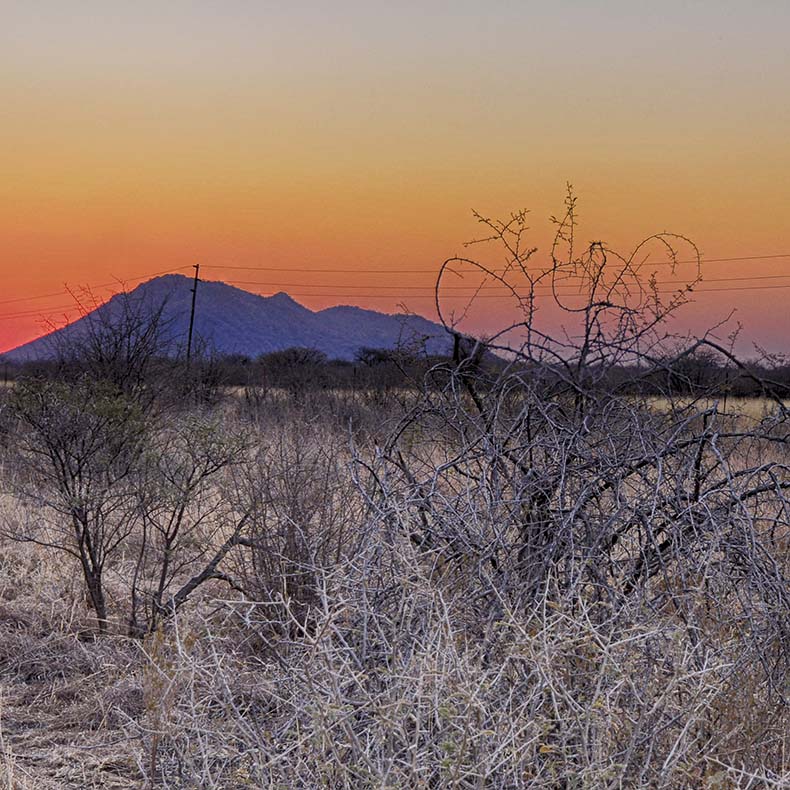
We have bushes, the park fence and telephone poles yet we could have stopped at a viewpoint such as this one...!
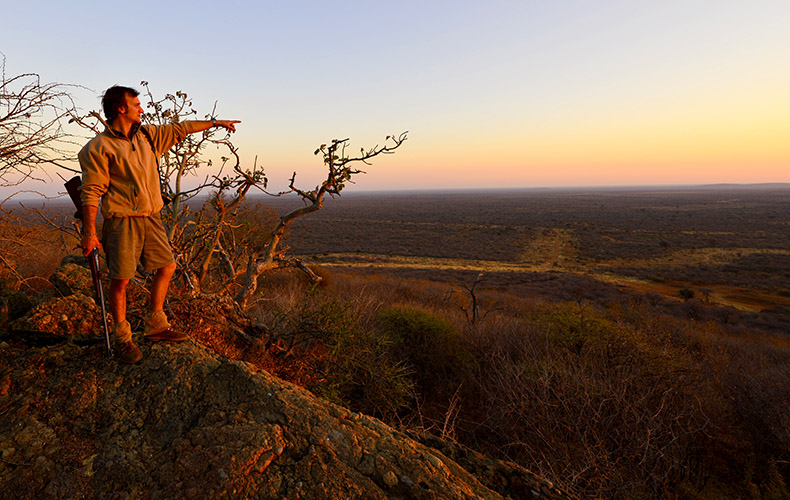
It just takes a little planning and communication on the part of the safari field guide.
When we convince a field guide to stop for drinks at a high view-point the majority of guests forget about the sun-downers as they are too engrossed with photographing the amazing vista before them!
It's so good to see the guests taking out their iPhones, iPads or DSLRs to photograph the landscape as opposed to stopping in the middle of the bush where everyone just looks at each other while standing around with their drinks in their hands.
Safari Field Guides - Guest Etiquette:
Are safari field guides taught how to communicate with guests, i.e. to ask if/when they can start the engine, pull off, is the position is OK or if there are twigs in the way, etc.? This is obviously related to photography but should be common practice for all guests whether photographers or not.
Many guides ask their guests "what would you like to see?" and we always answer 'Leopard please'. We then normally get the answer "well you know it's very difficult to find leopards - we don't find them, they find us, but we'll try".
I don't understand why they then ask - we understand that game drives can be hit and miss as that is what the bush is like but the field guide is supposed to be the expert in animal behavior, that's why guests pay much more to go on guided safaris as opposed to doing self-drive.
We don't ask for the extremely rare subjects such as pangolin, serval, aardvark and aardwolf, as we know these can be once-in-a-lifetime sightings and are a big bonus if seen.
The 'finder' guide tends to go out earlier then the 'follower' and he tends to do more research and as a result he is rewarded with the better sightings.
We found that at most lodges the safari field guides tend to leave the lodge at sunrise but at a few lodges the guides left 30 minutes earlier, which gave us a big advantage. I'm sure most guests won't mind getting up half an hour earlier so that they can find subjects in good light? The proactive, committed safari field guide will suggest this to guests while the follower/clock-watcher won't.
The field guide also needs to be able to negotiate with and control his guests. We were staying at Pilanesberg Private Lodge and we had seen a pride of lions at a nearby dam at midday but the light was not good so we decided to come back just before sunset.
That afternoon new guests checked in who were on our vehicle and they wanted to see elephants. Problem for the safari field guide as he knows we want to see the lions and these guests want elephant? Not at all - it just took some negotiating and planning!
The field guide told the guests that we were going to see lions (as we already knew where they were!) and they were excited but when we got there the lions were still sitting under bushes way behind the waterhole.
Our guide knew they would be drinking at the waterhole soon so he had to come up with a plan to keep the guests at the hide so he set up the drinks and snacks in the hide - brilliant tactics!
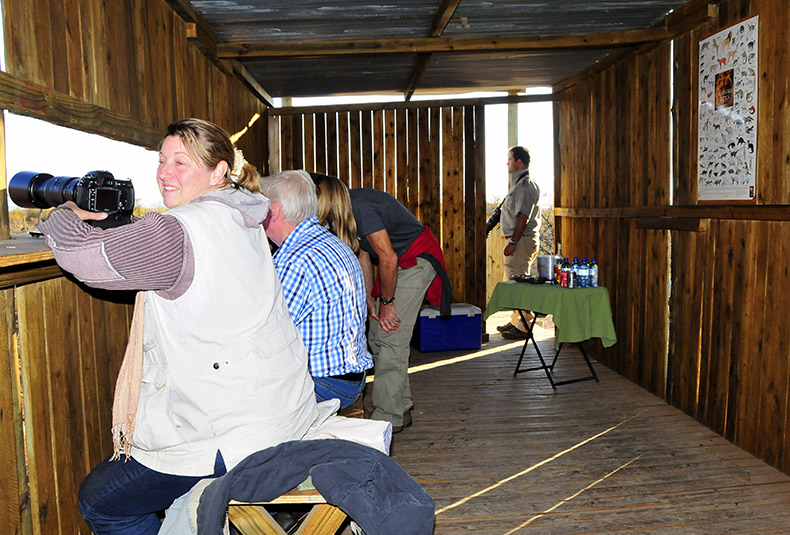
The lions did drink as the sun was setting - all the guests were happy - and as we left the hide we came across an elephant so it was win-win for everyone!
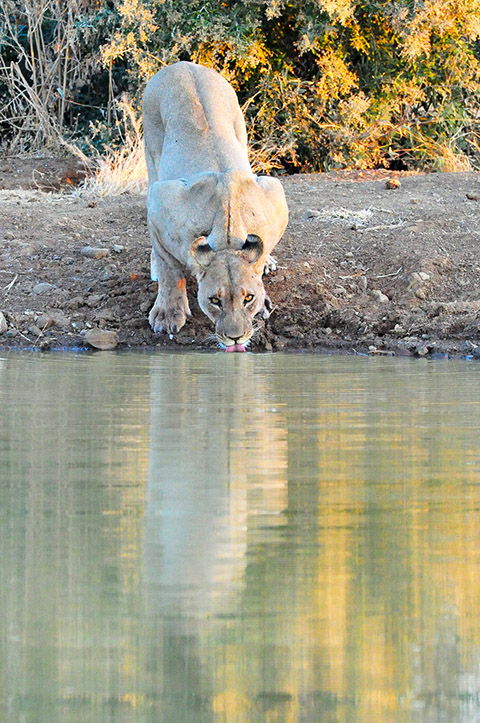 Lioness drinking at Leeupan while staying at Pilanesberg Private Lodge
Lioness drinking at Leeupan while staying at Pilanesberg Private Lodge“Our best sightings came from our driver receiving a radio call (fair enough) at which point we rushed to the sighting without being informed of why we were driving with urgency. It would be nice as a guest to stay informed as opposed to having to ask all the time”.
Edward says he was taught these things but some guides seem to forget what they were taught or think it's not important so a positive attitude is important in a guide.
Safari Field Guides - General Attitude:
The guide’s attitude and enthusiasm is also important as guests spend at least 6 hours each day with the guide. At some lodges the guide joins the guests for dinner so you could be spending up to 10 hours per day with the guide. If they are not passionate, pleasant and enthusiastic it’s going to be an awkward day and night!
“Our guide is knowledgeable, goes the extra hundred miles to make sure that all the guests are comfortable, and does his utmost to ensure that everyone sees everything that they have on the wish list. He also stays out longer if there is something of interest.”
We have had guides that have driven past a lion kill that was no more than 20 meters from the road – they were too busy chatting with each other to bother about looking for game. And then when we did stop to photograph the lions on the zebra kill they looked so disinterested and bored.
“Our driver appeared
very disinterested in actually assisting with animal sightings and practically
drove straight past the animals before we, the guests had to shout for him to
stop. I could feel the annoyance in our vehicle growing by the second.”
We have also found that some safari field guides are clock-watchers – they will spend no more than the suggested 3 hours on each game drive. On one safari we heard a call come over the radio for a leopard (Nkwe) at a dam that was about five kilometres from the lodge and the guide simply ignored the call and when I challenged him he said it was too far away and we needed to be back in time for dinner – all the usual excuses.
That’s why it’s important for guests to know what the names of dams, roads and viewpoints are and what the animal names are in the local language – so that the guides can’t lie to you!
“On our way back in the evening Franco asked if we wouldn't mind being a little later for dinner as he wanted to see if the leopard had taken the kill up the tree. What transpired for the next hour will be an experience which will remain etched in our minds forever. Watching the leopard take the impala up the tree and secure it was undoubtedly one of the most moving experiences.”
What does all this mean to you the guest / wildlife photographer?
Please remember that a tip/gratuity is for the extra effort that a guide puts in, just like a waiter at a restaurant. Poor service should mean no tip or less tip and exceptional service should equate to a very good tip.
If we reward poor service then the guide will think
he’s doing great and will not change his or her behaviour.
Yes, we have had many ‘clock-watcher’ guides but we have also had some very nice surprises where some guides actually volunteer to wake up two hours earlier in order to take us to a viewpoint so that we can photograph the sunrise or who, on one of their days off, volunteer to take us on a game drive to look for the elusive leopard!!
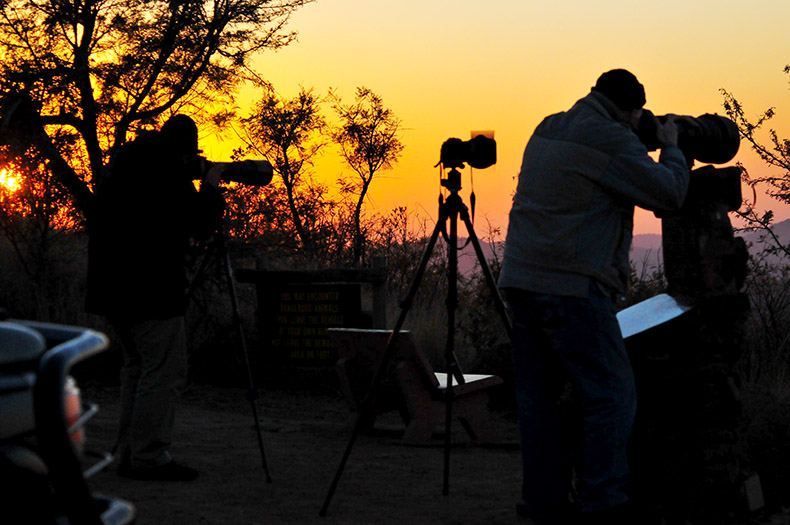 Edward and Mario photographing sunrise in the Pilanesberg
Edward and Mario photographing sunrise in the PilanesbergWe understand that when there are 3 or 4 groups of people on a vehicle the field guide has to try and please all of them but it is possible if the safari field guide knows his subjects, knows the park and has a desire to help the guests. Plus most guests stay for 2-3 days so what we don’t see today we could see tomorrow.
We were fortunate at the one lodge in Madikwe as it was just Jenny and I and one other couple who also had the same desires as us so we asked the field guide to drive to a waterhole so we could just sit and wait for the subjects to come to us.
He looked most surprised at this request but did as
we asked but while we were sitting at the waterhole, Melorane, we heard a lion roaring
in the distance. The guide then proceeded to start the vehicle and we all asked
what he was doing?! He said we must go and find the lions so we replied, no, we
want to stay at the waterhole – he could not believe this request – it seems
that the guides are conditioned to chase after the predators no matter what.
We ended up seeing 3 of the big-five - elephants,
rhinos and buffalo - just by sitting there for the afternoon. Eventually we
left the waterhole as we could see the guide was getting restless and agitated –
I guess they are not taught the benefits of sitting at a water source during
winter months?
At our next lodge (Motswiri) we told the field guide about the waterhole and he suggested we go and sit there even though his lodge is on the west of the park and the waterhole is in the east. We took him up on the offer and got to see more rhinos, spotted hyenas, buffalo and two leopards - one at the waterhole and one on the road back to the lodge!
Other Options to the Game Drive...
The game drive can be the highlight of your safari but if, for whatever reason, you're not enjoying the drives or they are becoming monotonous then keep in mind that you can do other activities. Some lodges offer bush walks, have hides that you can sit at by day or night or you can simply sit at the lodge and do the 'Sofa Safari'!
Most lodges have waterholes and while the game drive is out there could be action happening at the waterhole. On our one safari, we were staying at Tau Lodge in Madikwe and we decided on the last morning to sleep in, which turned out to be a very good choice as a pack of wild dogs chased and killed a kudu right in front of the lodge!
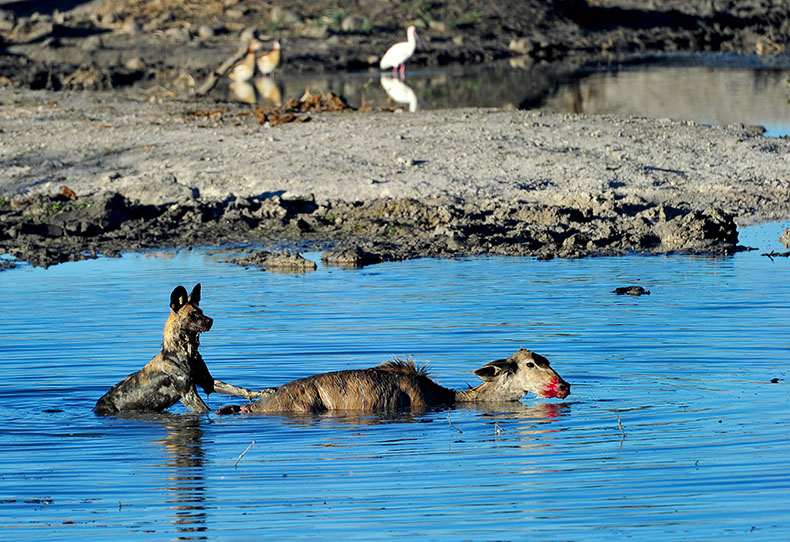
Another option is to photograph birds in the lodge or to photograph insects and wild flowers if you have a macro lens. We have found our most enjoyable safaris have been when we mix game drives with sofa safaris.
Safari Field Guides - Conclusion
If you are on a 3-day safari and you notice that your safari field guide is stubborn or disinterested then you are entitled to ask the lodge manager to please change you to another vehicle and guide. We have done this on at least three occasions and there have been no problems – the general manager wants happy repeat guests and good TripAdvisor ratings!
We would also suggest to the lodge owners and general managers that they hire a seasoned photographer to provide this kind of training to the safari field guides.
The safari lodge business is very competitive and most are looking for a unique selling proposition that will make their lodge stand out from the competitors – having safari field guides who are a cut above the rest should achieve this and would add so much more value to each guest’s game drive experience.
Our final bit of advice to the lodges:
- Find out which guests are safari first-timers and put them together as they may want to know what the gestation period is of a giraffe, while seasoned safari-goers have heard it all before.
- Please don't put photographers together with a family with small kids - the kids make a noise, jump around in the vehicle and just become a nuisance - rather put the family with kids on their own vehicle. It may cost you more as the lodge but it will ensure that your other guests are happy and come back!
- And please keep in mind that wildlife photographers are not your enemy - we may be more demanding than the average guest but we add value to each game drive as we assist other guests in getting better images. We have had so many guests thanking us for assisting them with getting the great shot by just showing them a small trick or two - if the safari field guides were better trained they could be getting the thanks.
You can read our interview with Edward here.
Return from Safari Field Guides to Kruger2Kalahari Home Page
To make a safari rental booking in South Africa, Botswana or Namibia click here
"It's 768 pages of the most amazing information. It consists of, well, everything really. Photography info...area info...hidden roads..special places....what they have seen almost road by road. Where to stay just outside the Park...camp information. It takes quite a lot to impress me but I really feel that this book, which was 7 years in the making, is exceptional." - Janey Coetzee, founder of CAROK (Camps and Roads of Kruger) South Africa
"Having a passion for the region itself and having to know about all dynamics, water holes and ideal roads for a period of 6 years - I wish I had this guide on my first trip already!" - Morkel Erasmus, Secunda, South Africa
"Mario and Jenny take you to places that are not always visited, and their descriptions of the more remote camps will allow you to make an informed decision without wasting time and money" - Bob & Sherry Shepardson, DeBary, Florida, USA
"Your time and money are valuable and the information in this book will help you save both." - Don Stilton, Florida, USA
"I highly recommend the book to anyone visiting Etosha National Park to photograph the animals - or anyone considering an African photography safari in the future." - Anne Darling, Cognac, France
"As a photographer and someone who has visited and taken photographs in the Pilanesberg National Park, I can safely say that with the knowledge gained from this eBook, your experiences and photographs will be much more memorable." - Alastair Stewart, BC, Canada
"This work is so much more than an eBook, because it is also a guide, a tutorial, an inspiration and a must-have for anyone interested in wildlife photography" - Findtripinfo.com, USA
Photo Safaris on a Private Vehicle - just You, the guide & the animals!
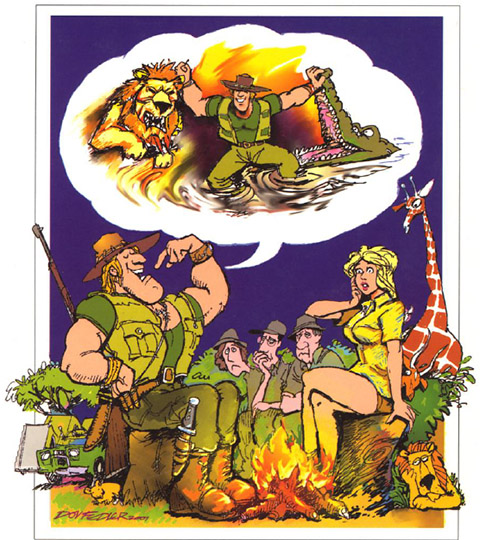
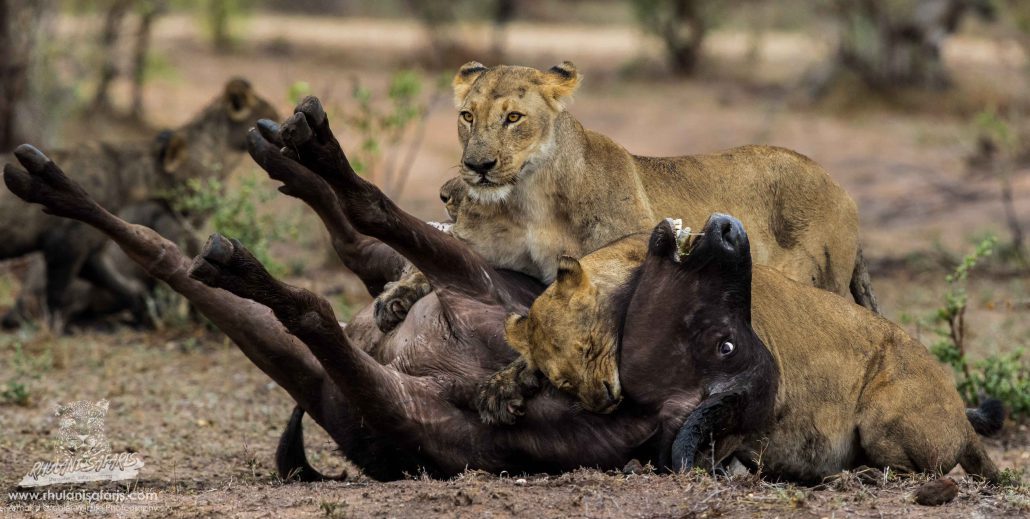
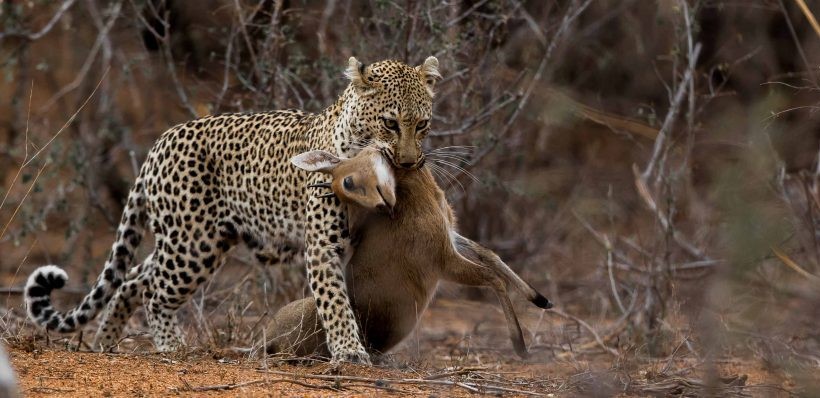










New! Comments
Have your say about what you just read! Please leave us a comment in the box below.